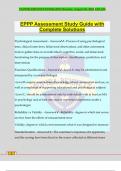©SOPHIABENNETT@2024-2025 Monday, August 26, 2024 6:09 AM
EPPP Assessment Study Guide with
Complete Solutions
Psychological Assessment - Answer✔️✔️--Process of using psychological
tests, clinical interviews, behavioral observations, and other assessment
tools to gather data on an individual's cognitive, social, and behavioral
functioning for the purpose of description, classification, prediction, and
intervention
Examiner Qualifications - Answer✔️✔️--Level A: may be administered and
interpreted by a non-psychologist
-Level B: require some technical knowledge of test construction and use, as
well as completion of supporting educational and psychological subjects
-Level C: should be administered only by individuals with at least an MA
in psychology and at least one year of supervised experience under a
psychologist
Reliability vs Validity - Answer✔️✔️--Reliability: degree to which test scores
are free from the effects of measurement error
Validity: degree to which a test measures what it was designed to measure
Standardization - Answer✔️✔️--The examinee's responses, the apparatus,
and the scoring have been fixed so the scores collected at different times
1
, ©SOPHIABENNETT@2024-2025 Monday, August 26, 2024 6:09 AM
and places are fully comparable; any deviations from standardized
administration and scoring may result in invalid conclusions
-The test has been administered under standard conditions to a
representative sample for the purpose of establishing norms; the greater
the discrepancy between the examinee and the norm group, the less likely
the test results will be valid
Types of Scoring - Answer✔️✔️--Norm-Referenced: comparison between an
examinee's scores and the scores of the norm group; percentile ranks,
standard scores
-Criterion-Referenced: domain or content referenced; scores based on what
the examinee can do or knows with regard to clearly defined content;
percent correct
-Self-Referenced: ipsative; intra-individual comparison of scores; relative
strengths or weaknesses
Behavioral Assessment - Answer✔️✔️--Focuses on overt and covert
behaviors that occur in specific circumstances
-May utilize behavioral interviews, observation, cognitive assessment, or
psychophysiological measures
-Functional behavioral assessment (FBA): determines the purpose of a
behavior by identifying antecedents and consequences
2
, ©SOPHIABENNETT@2024-2025 Monday, August 26, 2024 6:09 AM
Dynamic Assessment - Answer✔️✔️--Interactive approach and deliberate
deviation from standardized procedures to obtain additional information
about the examinee
-Associated with educational assessment
-Testing the limits: involves providing examinees with additional cues,
suggestions, or feedback; ordinarily done after standardized
administration
-Graduated prompting: giving the examinee a series of verbal prompts that
are graduated in terms of difficulty level
-Test-teach-retest: following the initial assessment with an intervention
designed to modify the examinee's performance, then re-assessing
Computer-Assisted Assessment - Answer✔️✔️--Computer Adaptive Testing
(CAT): computer tailors the test to an individual examinee by choosing
subsequent items based on previous answers
-Increases precision and efficacy, as all examinees are tested with the same
degree of reliability and reduced testing time
-Computer-based interpretations should not be used to replaced clinical
judgement
Actuarial vs Clinical Predictions - Answer✔️✔️--Actuarial: statistical; based
on empirically validated relationship between test results and specific
criteria
3
, ©SOPHIABENNETT@2024-2025 Monday, August 26, 2024 6:09 AM
-Clinical: based on the decision-maker's intuition, experience, and
knowledge; clinical judgement
-Research has found that actuarial method alone is more accurate than
clinical judgement alone
Assessing Children - Answer✔️✔️--Interviews can be used to obtain reliable
and valid data from children as young as 6
-Goals include establishing rapport and maintaining the child's
cooperation, and can be accomplished by using descriptive statements,
reflections, and open-ended questions; providing labeled praise; and
avoiding critical statements and leading questions
Assessing Members of Culturally Diverse Populations - Answer✔️✔️--
Considerations include acculturation, identity, language proficiency,
availability of appropriate norms, cultural equivalence of content measured
by the test, and availability of more culturally appropriate alternatives
-There are no truly culture-fair or culture-free tests
-Research has found no consistent effect of match or mismatch between
examiner and examinee in terms of race, ethnicity, or culture
Self-Report - Answer✔️✔️--One of the most common data collection
methods
-Advantages include quick production and scoring, and low cost
4




